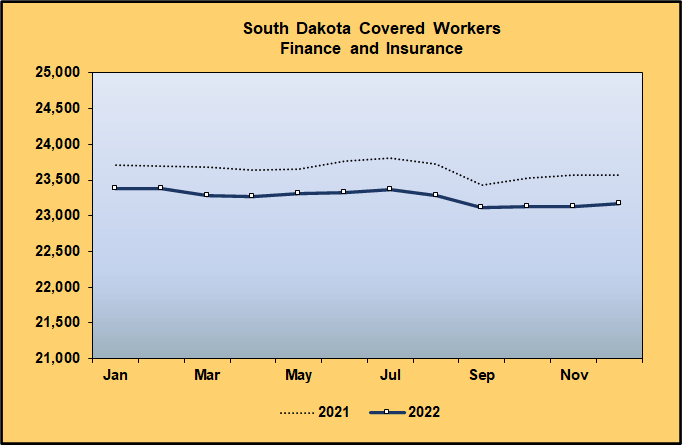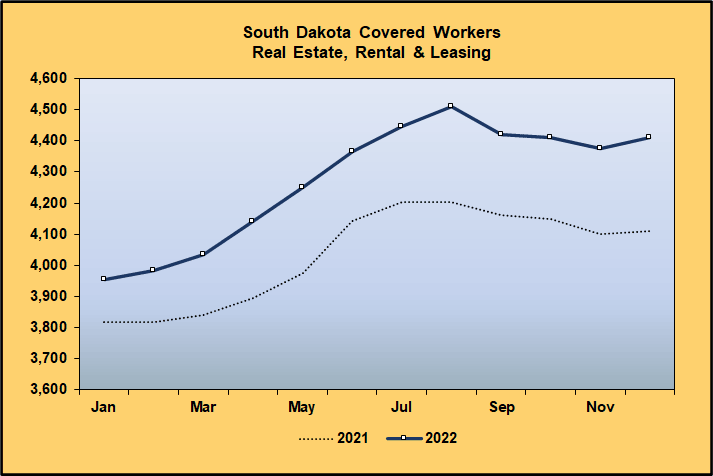- Home to LMIC
- Virtual Labor Market Data System
- Career Exploration & Planning
- Consumer Price Index
- Demographics
- Economic Snapshot
- Employee Benefits
- Employment Projections
- Labor Force & Unemployment
- Labor Supply
- Overview of the Current Labor Market
- Surveys We Conduct
- Wages & Income
- Workers by Industry
- Tools & Resources
- Publications
- References
- What's New
- Can't Find It?
Labor Market Information Center
2022 Annual Report
Quarterly Census of Employment and Wages
Financial Activities Supersector
The Financial Activities supersector is comprised of the Finance and Insurance sector and the Real Estate and Rental and Leasing sector. Businesses within this supersector are involved in financial transactions or renting or leasing tangible or intangible assets.
|
South Dakota Covered Workers and Pay 2022 |
|||
| Supersector, Sector and Subsector | Number of Establishments | Average Number of Workers | Annual Pay |
| Financial Activities | 4,221 | 27,536 | $77,445 |
| Finance and Insurance | 2,788 | 23,261 | $82,456 |
| Credit Intermediation and Related Activities | 989 | 14,748 | $80,389 |
| Securities, Commodity Contracts and Investments | 499 | 1,454 | $143,501 |
| Insurance Carriers and Related Activities | 1,260 | 6,978 | $74,199 |
| Funds, Trusts and Other Financial Vehicles | 40 | 82 | $73,402 |
| Real Estate and Rental and Leasing | 1,433 | 4,275 | $50,178 |
| Real Estate | 1,266 | 3,422 | $49,391 |
| Rental and Leasing Services | 154 | 802 | $51,716 |
| Lessors of Nonfinancial Intangible Assets | 13 | 52 | $77,269 |
| Totals may not add due to rounding. Data subject to revision. Produced by the Labor Market Information Center, South Dakota Department of Labor and Regulation, in cooperation with the U.S. Bureau of Labor Statistics. |
|||
Finance and Insurance
NAICS 52
The Finance and Insurance sector saw a loss of 391 workers (1.7%) in 2022 for average annual employment of 23,261. Average annual pay increased to $82,456 from $77,946. This sector ranks fourth and sixth in average annual wage and average employment, respectively.
The Finance and Insurance sector comprises establishments that are primarily engaged in financial transactions and/or facilitating transactions by three principal types of activities. The first activity is to raise funds by taking deposits or issuing securities and incurring liabilities. The second activity is to pool risk by underwriting insurance and annuities. The last activity is to provide specialized services facilitating or supporting financial intermediation, insurance and employee benefit programs.
The number of workers in the Credit Intermediation and Related Activities (NAICS 522) subsector decreased for the ninth consecutive year. The average annual employment in 2022 was 14,748, decreasing 3.3% from 2021. Average annual pay increased $3,526 (4.6%) to $80,389. Establishments within this subsector lend funds raised from depositors or from credit market borrowing and facilitate the lending of funds or issuance of credit. The transition to online services has likely contributed to the downward trend within this subsector. The use of advanced technology has caused a shift from traditional banking methods to modern banking methods. Currently the most common and useful technology-based banking methods are online banking, mobile banking, video banking, telephone banking, ATMs and plastic money. Internet banking has made life simple and convenient. Efficiency and time-saving methods have been the result. Internet is a cheap delivery channel for banking products and is allowing entities to reduce branch networks and downsize the number of service staff.
The Securities, Commodity Contracts and Other Financial Investments and Related Activities (NAICS 523) was one of two subsectors that saw an increase in employment in 2022. Average annual employment increased 7.9% to 1,454. The average annual wage increased 7.9% to $143,501 in 2022. Nearly all employment growth is attributable to establishments participating in customized investment advice, portfolio management and trust services for customers. Security brokerages and investment banking establishments which act as agents or brokers between buyers and sellers of securities and commodities saw minimal employment gain in 2022.
Although slight, the general downhill trend in employment has continued in the Insurance Carriers and Related Activities (NAICS 524) subsector. From 2021 to 2022, employment decreased 0.2% to 6,978. The annual average pay for the year was $74,199, an increase of 8.2%. This subsector includes establishments involved in selling annuities and insurance policies, claims adjusting and third-party administration of insurance and pension funds. Despite the minimal worker loss, this subsector remains strong because consumer demand remains high for their traditionally insured property (ranging from homes and other real estate holdings to automobiles and recreational equipment). Staff are needed in this subsector to handle the related workload.
The Funds, Trusts and Other Financial Vehicles (NAICS 525) subsector employs the least number of workers by a large margin within the Finance and Insurance sector. Employment grew to 82 in 2022, an increase of 41.4%. Establishments in this subsector, which generally only employ one or two employees each, are comprised of legal entities organized to provide insurance and employee benefits or to pool securities and other assets.

Real Estate and Rental and Leasing
NAICS Sector 53
The Real Estate and Rental and Leasing sector gained 238 workers (5.9%) from 2021 to 2022 for an annual average of 4,275. The sector had an average annual pay of $50,178, increasing by $3,364 (7.2%).
The sector is comprised of three subsectors:
- Real Estate (NAICS 531), which accounts for approximately 80% of workers in the sector
- Rental and Leasing Services (NAICS 532)
- Lessors of Nonfinancial Intangible Assets (NAICS 533)
The Real Estate subsector’s employment continued to grow in 2022 despite rising home prices and higher interest rates. Over the year, the number of workers grew 5.9% to 3,422. Employment gain was mostly attributable to the Activities Related to Real Estate industry group. The activities within this industry group are primarily property management, appraisals and escrow services. The Offices of Real Estate Agents and Brokers industry group saw a slight employment gain in 2022, but it was not as significant as it was in 2021.
Rental and Leasing Services, a stagnant/declining subsector over the years, saw an employment increase (5.9%) for an annual average of 802 in 2022. Worker gains were realized within automotive equipment and commercial and industrial machinery rental and leasing industries. Consumer goods rental establishments and general rental centers declined slightly.
The last subsector, Lessors of Nonfinancial Intangible Assets, increased by three workers to an annual average of 52 in 2022. The subsector contains only itself within its lone industry group. This industry has a very low number of workers, and establishments are mainly engaged in assigning rights to assets, such as patents, trademarks and brand names for which a royalty payment of licensing fee is paid to the asset holder.

